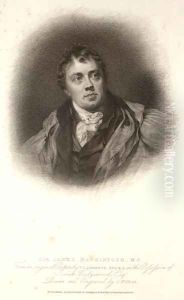Charles Wilkin Paintings
Charles Wilkin, born in 1750 and deceased in 1814, was a distinguished English engraver and painter, remembered for his significant contributions to the art of stipple engraving. Stipple engraving, a technique that involves engraving in dots to create soft, tonal effects, was a popular method in the late 18th and early 19th centuries for reproducing portraits and other works with a particular delicacy and refinement that Wilkin mastered and helped to popularize.
Wilkin's career began in London, where he initially apprenticed under a heraldic engraver. This early exposure to precision and detail would later be evident in his stipple engravings. Transitioning to portrait engraving, Wilkin established himself as a talented artist with a keen eye for capturing the essence and character of his subjects. His works often featured prominent figures of his time, contributing to the preservation and dissemination of their likenesses.
In addition to his contributions to engraving, Wilkin also engaged in miniature painting, showcasing his versatility as an artist. However, it is his stipple engravings that garnered him the most acclaim, with works that demonstrated not only technical skill but also a profound sensitivity to the aesthetics of his era. Wilkin's engravings were characterized by their exquisite detail, subtlety of tone, and the lifelike quality of the portraits, attributes that made his works highly sought after.
Throughout his career, Wilkin received numerous commissions from publishers, illustrating books and producing standalone portraits that circulated widely, further establishing his reputation. His engravings also featured in prestigious exhibitions, including those held by the Royal Academy, where he exhibited regularly, affirming his status within the artistic community of his time.
Charles Wilkin's legacy is that of an artist who significantly advanced the art of stipple engraving, influencing subsequent generations of engravers. His works remain a testament to the elegance and technical prowess of stipple engraving at its finest. Wilkin's death in 1814 marked the loss of a pivotal figure in English art history, but his contributions continue to be appreciated for their beauty and technical excellence.
